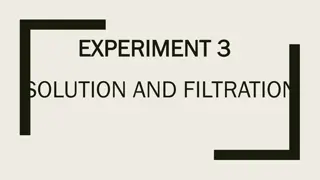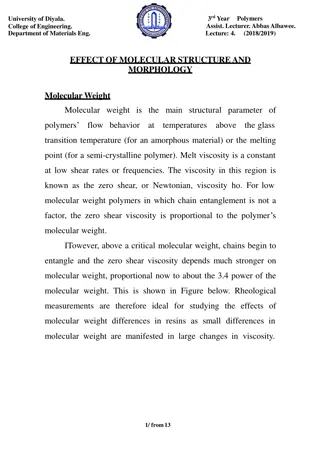Gel Filtration Chromatography: Separation and Molecular Weight Determination
Gel filtration chromatography is a method used for separating proteins based on their molecular weights. This experiment aims to teach students the principles of gel filtration chromatography and provide hands-on experience in the lab. By utilizing a stationary phase of porous beads and a mobile phase of NaCl, this technique allows for the fractionation of biomolecules without the need for protein binding. The separation is based on size, with larger molecules eluting first and smaller ones last.
Download Presentation

Please find below an Image/Link to download the presentation.
The content on the website is provided AS IS for your information and personal use only. It may not be sold, licensed, or shared on other websites without obtaining consent from the author.If you encounter any issues during the download, it is possible that the publisher has removed the file from their server.
You are allowed to download the files provided on this website for personal or commercial use, subject to the condition that they are used lawfully. All files are the property of their respective owners.
The content on the website is provided AS IS for your information and personal use only. It may not be sold, licensed, or shared on other websites without obtaining consent from the author.
E N D
Presentation Transcript
Experiment 7 Separation of molecules and determination of there molecular weight by gel filtration chromatography. BCH 333
Objectives: 1. The objective of this experiment is for students to learn the principles of gel filtration chromatography by separating the proteins according to the molecular weights. 2. A practical experience on gel filtration chromatography in the laboratory. 3. Importance of gel filtration chromatography and procedures in purification.
3-Gel filtration chromatography: -also called "Molecular Sieve or "Size or gel Exclusion . - important method in protein purification. -This separation method is unique in fractionating without requiring protein binding, thus significantly reducing the risk of protein loss. well suited for biomolecules that : - are very sensitive to the changes in pH, concentration of metal ions and cofactors and harsh environmental factors. - If the protein is relatively large (over 100 KDa), gel filtration could be used as an initial step in the purification.
Gel filtration chromatography Stationary phase: (column matrix) Mobile phase: buffer or solvent. "beads" of hydrated, porous polymer. In this lab the mobile phase is NaCl.
Principle: -Gel filtration chromatography separates proteins according to their size. And the molecules are "filtered" through the porous beads. -The gel filtration matrix[stationary phase] contains pores which permit the buffer, small and medium sized molecules to pass through them. -Large molecules can t get through any pores in the beads and move more rapidly through the column, emerging (eluting) sooner.[elute from the column before the smaller proteins]. - Medium-sized molecules can enter the larger size pores in the matrix, and so they reach the end of the column later. -Small molecules can enter through all pores of the beads and they have the largest volume to pass through before emerging from the column last. elute last.
The principle of gel filtration chromatography (Figure has been taken from- (http://mortada8.maktoobblog.com/category/instrumental-analysis-studies/chromatographystudies/)
Stationary phase [beads].info.: -The gels used as molecular sieves consist of cross-liked polymers that are generally inert, do not bind or react with the material being analyzed, and are uncharged. mobile phase: Is the liquid fills the space inside the beads and between the bead particles and this liquid occupies most of the bed volume .
Gel Filtration Resins The gels currently in use are of three types: dextarn, agarose, and polyacrylamide. 1-Dextran [e.g. Sephadex]: -is a polysaccharide composed of glucose residues. -prepared with various degrees of cross-linking to control pores size. -supplied in the form of dry beads that swell when water is added. - -It is mainly used for separation of small peptides and globular proteins with small to average molecular mass.
2-Polyacrylamide gels [Bio-gel P]: -Prepared by cross-linking acrylamide with N,N'methylenebisacrylamide. or in short:bisacrylamide -The pore size is determined by the degree of cross-linking. -Polyacrylamide gels are available in wide range of pore sizes. -The separation properties of polyacrylamide gels are mainly the same as those of dextrans.
3-Agarose[e.g. Sepharose Biogel A]: -is a linear polymer of D-galactose and 3,6-anhydro-1-galactose and forms a gel that is held together by hydrogen bonds. - Agarose is present in powder forms that are dissolved in water close to boiling temperatures , then cooled down to around 40 degrees it sets and forms a gel . -The concentration of the material in the gel determines the size of the pores. . Agarose gels have larger pore sizes compared to Dextran and polyacrylamide gels. -This makes it useful for the analysis or separation of large globular proteins or long, linear molecules such as DNA.
General information: -The pore size determines the range of molecular weight in which fractionation occurs. -gel beads come in various sizes: large, medium, fine, and superfine. So, -All consist of semi-permeable, porous gels of cross linked polymers with a range of pore sizes. -The degree of cross linking is controlled to yield a series of gels having different pore sizes.
The rule is: -The larger the beads, the more rapid the flow rate and the poorer the resolution. [because as the flow rate increases, the time available for the molecules to equilibrate between the mobile phase and the pore space in the stationary phase decreases.] When it is used??? The larger beads are for very large preparation in which resolution is less important than time. -super fine, is used if maximum resolution is required and the time is less important.
Advantages of gel filtration: It is the best method for separation of molecules differing in molecular weight because: 1. It doesn t depend on temperature, pH, ionic strength and buffer composition, so, separation can be carried out under any conditions. 2. There is very little adsorption. 3. There is less zonal spreading than in other techniques. 4. The elution volume is related to the molecular weight.
To estimate the molecular weight for a protein: 1. several proteins with known molecular weights are run on the column and their elution volumes determined. 2. the elution volumes are then plotted against the log molecular weight of the corresponding proteins. 3. a straight line is obtained for the separation range of the gel being used. 4. the elution volume of a protein of unknown molecular weight is then found, [it can be compared to the calibration curve and the molecular weight determined.]
elution volume, Veis proportional to log of molecular weight. For high molecular weight less elution volume is needed, and for small molecular weight the large elution volume is needed to elute the sample.
Cautions must be taken: It is important that the gel should be: -Homogenous. -Free from bubbles. -Free from cracks. -Free from spaces between the walls. - And it should be covered by the liquid "mobile phase" all the time.
For every column, three volumes should be distinguished: 1. The void volume, Vo: - The volume of the mobile phase in the space between the beads . [which is the volume external to the beads]. -Can be determined by the elution of High MW molecules which can not enter any pores . 2. The total volume, Vt (bed volume): -The total volume of material in the column (both solid and liquid). [can be calculated from the dimension of the column.] 3. The elution volume, Ve, of molecules: - the amount of liquid( mobile phase) that must be added to produce a peak of a particular solute in the effluent. -Or the volume required for completely eluting the solute from column.
-Loading the sample : small volume of sample is placed on the stationary phase and allowed to enter the column. -Packing the column: Preparation of the gel and loading it in the column.
The most common application of gel filtration in biochemistry are: -Molecular weight determination. -Fractionation of macromolecules. -purification.
Practical Considerations -Gels of various pore size are available choose the one with the best fractionation range for your sample -Good separation usually require long columns and slow flow rate. -Gel filtration is NOT recommended for separating proteins with only a small difference in molecular weight .
The gel filtration material that will be used in the experiment is called Sephadex G-100 and it will separate molecules with molecular weights from 4,000 to 150,000. So, Those molecules which are with molecular weight larger than 150,000 will be excluded from the beads, because of their huge size they can not get through the pores of the beads. In your experiment: you will separate a mixture of blue dextran with m.wt.= 2,000,000 and bromophenol blue m.wt.= 669.99 .






















